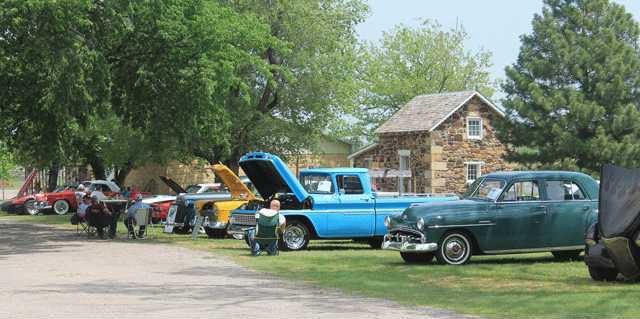Whether it was dragsters, street rods, Mopars, or vintage cars that struck their fancy, visitors and exhibitors alike were drawn to the Second Annual Barton Historical Society Museum Rolling Sculpture car show Saturday afternoon, May 18.
Members from several area car clubs and out of town owners of some of the past centuries most striking automobiles came to help celebrate the 60th anniversary of the SRCA drag strip and racing in Great Bend.
Rich Fox, a veteran organizer of area car clubs and a street rod aficionado, gave the Tribune a run down on the different kinds of cars on display. There were vintage cars, which are maintained to their original specifications, using vintage parts and lots of love. There are street rods, which look vintage, but are outfitted with modern electrical systems, heat and air conditioning, modern suspension and high tech modern engines.
“My brown street rod, I’ll drive from coast to coast in comfort,” Fox said.
Mopars are lovingly restored and maintained by fans of the Chrysler group of automobiles. There’s also a good following of the Chevrolet arm of automobiles too. Also on the scene were modified dragsters, like the 1937 Chevy Coupe owned by Dan Kaiser.
“I’ve owned the car since 1981. It was out of a pasture when I bought it,” he said. “My wife thought I was nuts when I brought it home.”
He transported what was left of it home on a pallet. It had rusted out floor boards, the doors were all but gone, and it was nothing but tubes. He’s worked on it ever since, periodically updating it and doing all the work himself.
“What it is — is my hands,” he said.
It took nine years to build it. He raced it for the first time in 1999 at Topeka, where he won an award for best engineered at ET finals. He still races it, but now it sports an injected alcohol engine, and goes over 160 mph.
“It’s a labor of love,” he adds. “You’ll never get out of it what you put into it.” The sentiment is echoed by every car owner at the show. Some have put tens of thousands of dollars and hundreds of hours of work into their cars. Some like to race, while others like the idea of owning a piece of history. But among them all, there is pride of accomplishment and ownership.
On display in the museum library, video footage from the infant days of the SRCA dragstrip was available to view. Many of the cars on display Saturday looked as if they too could have graced that track in their day. Many still do.
The day the sculptures rolled in





